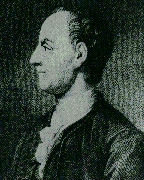
Leonhard Euler
1707-1783

Born in Basel, Switzerland. Mathematical development influenced by the Bernoullis. Professor in St. Petersburg 1726-1741, then Berlin, 1741-1766, then back to St. Petersburg. Was the central figure in 18th century mathematics, especially in analysis. Extended the development of calculus following Leibnitz' approach, used complex numbers in calculus, made analysis accessible to physicists in the context of dynamics, studied partial differential equations, elliptic functions, calculus of variations. Most prolific mathematician of all time. Euler's collected works (not complete) come to more than 70 volumes. Went blind during the second period in St. Petersburg with no apparent change in his productivity.
Specific contributions to physics include his work on the calculus of variations and the variational (Euler) equations, analysis of the physical pendulum, formulation of the principle of least action, demonstration that free motion on a surface is geodesic, introduction of the principal axis transformation in the theory of vibrations, integration of the two-center gravitational problem in the plane, the introduction of Euler angles and moving coordinates in the description of rotations, separation of rotations and the motion of the center of mass, parametrization of rotations by Euler parameters (related to a quaternion description of rotations that came much later), and formulation of Euler's equations for the rotation of a rigid body